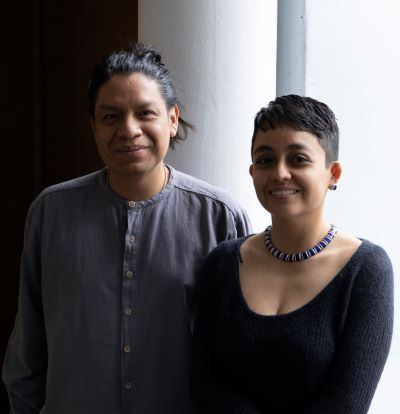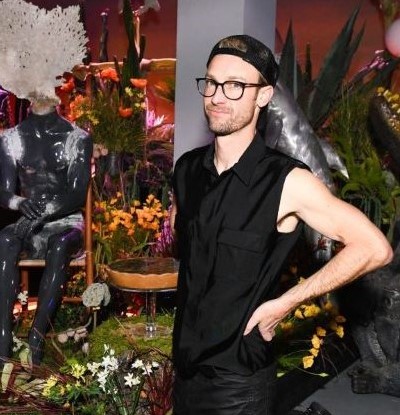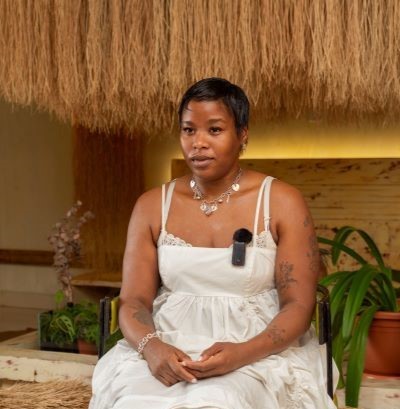Bringing New Public Art to Campus
The Stuart Collection’s Emerging Artists Program to support new and diverse voices
Story by:
Media contact:
Published Date
Story by:
Media contact:
Share This:
Article Content
UC San Diego has transformed into a place that sparks intellect and curiosity at nearly every turn. You don’t need to be in a classroom or a lab — simply look around, toward the sky or even the ground, and you’ll soon encounter inspiration from the Stuart Collection, the university’s assemblage of permanent, site-specific artworks embedded into the landscape and culture of the campus.
Devoted to enriching all aspects of the UC San Diego experience since its inception in 1981, the Stuart Collection has commissioned more than 20 public works by globally celebrated artists for all campus community members, locals, art aficionados and visitors to enjoy. Now, plans have been announced to bring exciting new creations to campus through the Emerging Artists Program, with three installations expected to be completed between spring 2025 and fall 2026.
The Emerging Artists Program
Designed to bring new and diverse voices to UC San Diego to expand the Stuart Collection, the Emerging Artists Program will commission artists who contribute to the Stuart Collection’s discourse on contemporary art by engaging with a wide range of ideas, histories, ecologies, identities and materialities. The program aims to support experimental practices and the exploration of ideas that embrace current cultural contexts and resonate with local and international audiences.
“The Stuart Collection is an important catalyst of UC San Diego’s transformation into a destination public university,” said UC San Diego Chancellor Pradeep K. Khosla. “The Emerging Artists Program will build upon our commitment to foster belonging, connection and community among our scholars and visitors from around the world and further our reputation as a renowned destination for arts and culture.”

The Stuart Collection has selected artist collective RojoNegro, composed of Noé Martínez and María Sosa; sculptor Max Hooper Schneider; and poet, artist and chef Precious Okoyomon as the inaugural artists of the program. Each artist will be completing their first permanent public art installation through the Emerging Artists Program and will make a lasting impact on the campus and greater community.
“We are honored to add the works of RojoNegro, Max Hooper Schneider and Precious Okoyomon to the Stuart Collection. These artists enrich our contemporary art discourse and will provide our communities the opportunity to engage with cutting-edge art and with new voices in the art world while supporting UC San Diego's mission to foster creativity, critical thinking and interdisciplinary collaborations,” said Jess Berlanga Taylor, director and curator of the Stuart Collection.
Meet the Inaugural Emerging Artists
By integrating up-and-coming artists, the Stuart Collection continues to showcase a broad range of cultural, social and artistic experiences. RojoNegro’s work will mark the first Stuart Collection commission by Latinx artists, and Okoyomon’s work will be the second by a Black artist and the first whose work addresses histories of colonization and enslavement. Hooper Schneider’s interdisciplinary focus will uniquely speak to UC San Diego’s history.
RojoNegro: Noé Martínez (he/him/his) and María Sosa (she/her/hers)

Based in Mexico City, artist collective RojoNegro focuses on the lived experience of Indigenous communities and artistic interpretations of communal histories, of which shared experiences of resistance and the celebration of their heritage are crucial elements. Martínez’s work has functioned as a case study that emerges from personal history, using ethnographic methodologies and research on the various histories of Indigenous communities. Sosa’s practice has developed from research about colonial pasts and how they shape contemporary racial, sexual and social dynamics. She particularly highlights the eroding knowledge surrounding non-Western ways of life and pre-Hispanic cultures.
Max Hooper Schneider (he/him/his)

Hooper Schneider’s work is informed by traditional research and the materials endemic to a venue or site, with his formal training in marine biology and landscape architecture often influencing his sculptural practice. The artist’s work decentralizes humans and instead shifts the viewer’s focus to the natural phenomena contributing to each piece. His project will engage with elements of marine science research conducted at UC San Diego’s Scripps Institution of Oceanography.
Precious Okoyomon (they/them/their)

Precious Okoyomon, photo courtesy of the Museum of West African Art (MOWAA).
Okoyomon is a Nigerian-American poet, artist and chef. Their work considers the natural world, histories of migration and racialization and the pure pleasures of everyday life. Okoyomon, who currently represents Nigeria in the 2024 Venice Biennale — one of the art world’s most prestigious events — stages sculptural topographies composed of living, growing, decaying and dying materials. Through installation, Okoyomon articulates the inseparability of the natural world from the historical force of colonization and enslavement.
Share This:
You May Also Like
Stay in the Know
Keep up with all the latest from UC San Diego. Subscribe to the newsletter today.




